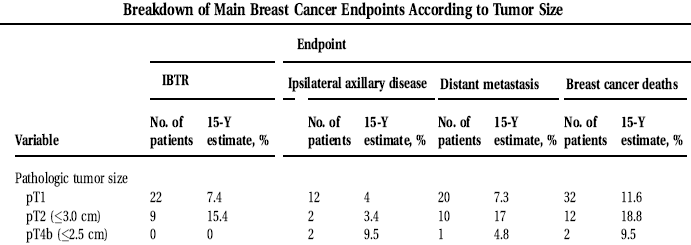|
Elderly breast
cancer patients treated by conservative surgery alone plus adjuvant
tamoxifen : Fifteen-year results of a prospective study (p 481-488)
Gabriele Martelli, Cancer 2007;112:481
In elderly patients with early breast
cancer and a clinically clear axilla, axillary surgery, sentinel
lymph node biopsy, and postoperative radiotherapy to the residual
breast may not be necessary because of reduced life expectancy,
effectiveness of hormone therapy in achieving long-term disease
control, and generally favorable biologic behavior of breast cancer
in elderly patients.
METHODS. The authors followed
354 prospectively recruited
women aged
 70
years who had primary, operable breast cancer and no palpable
axillary lymph nodes. All 354 women were treated with conservative
surgery and adjuvant tamoxifen and without axillary dissection or
postoperative radiotherapy. Women who had resection margins in tumor
tissue were excluded.
Endpoints were cumulative incidence of axillary disease, cumulative
incidence of ipsilateral breast tumor recurrence (IBTR), and breast
cancer mortality. 70
years who had primary, operable breast cancer and no palpable
axillary lymph nodes. All 354 women were treated with conservative
surgery and adjuvant tamoxifen and without axillary dissection or
postoperative radiotherapy. Women who had resection margins in tumor
tissue were excluded.
Endpoints were cumulative incidence of axillary disease, cumulative
incidence of ipsilateral breast tumor recurrence (IBTR), and breast
cancer mortality.
RESULTS. After a median follow-up
of 15 years (interquartile range, 14-17 years), the crude cumulative
incidence was 4.2% (4% in pathologic T1 [pT1] tumors)
for axillary disease, 8.3%
(7.3% in pT1 tumors) for IBTR, and 17% for breast cancer mortality.
Of the 268 patients who died during follow-up, 222 patients (83%)
died from causes unrelated to breast cancer.
CONCLUSIONS. Elderly patients with early
breast cancer and no palpable axillary lymph nodes may be safely
treated safety by conservative surgery without axillary dissection
and without postoperative radiotherapy, provided that surgical
margins are in tumor-free tissue and that hormone therapy is
administered. Sentinel lymph node biopsy is also unnecessary because
of the low cumulative incidence of axillary disease, and axillary
surgery can be reserved for the small proportion of patients who
later develop overt axillary disease.

|
 70
years
70
years 